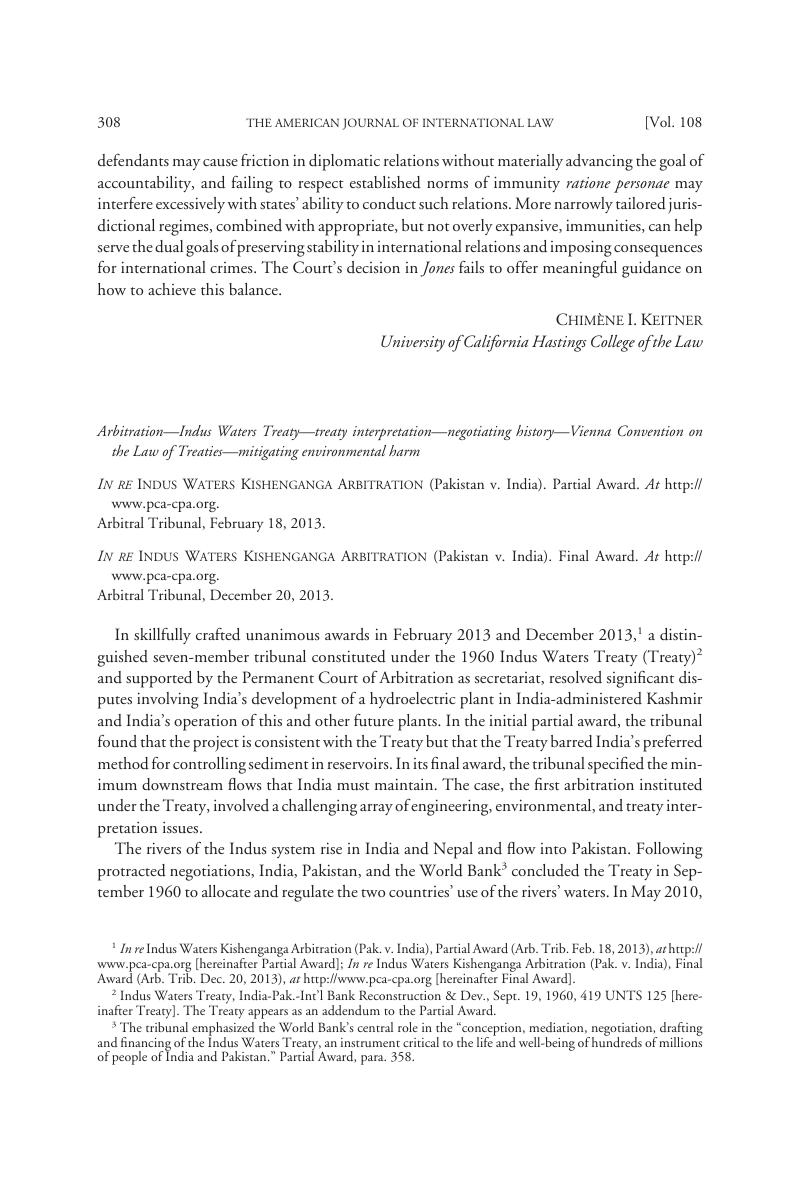Published online by Cambridge University Press: 20 January 2017

1 In re Indus Waters Kishenganga Arbitration (Pak. v. India), Partial Award (Arb. Trib. Feb. 18, 2013), at http://www.pca-cpa.org [hereinafter Partial Award]; In re Indus Waters Kishenganga Arbitration (Pak. v. India), Final Award (Arb. Trib. Dec. 20, 2013), at http://www.pca-cpa.org [hereinafter Final Award].
2 Indus Waters Treaty, India-Pak.-Int’l Bank Reconstruction & Dev., Sept. 19, 1960, 419 UNTS 125 [hereinafter Treaty]. The Treaty appears as an addendum to the Partial Award.
3 The tribunal emphasized the World Bank’s central role in the “conception, mediation, negotiation, drafting and financing of the Indus Waters Treaty, an instrument critical to the life and well-being of hundreds of millions of people of India and Pakistan.” Partial Award, para. 358.
4 Dead storage refers to the water behind a dam below the level at which water is diverted for power generation. Dead storage increases the height from which water is diverted, and thus its potential to generate power. Pondage is the water above dead storage; the level of pondage may fluctuate as needed to meet incoming flows and to generate power.
5 In re Indus Waters Kishenganga Arbitration (Pak. v. India), Order on Interim Measures (Arb. Trib. Sept. 23, 2011), at http://www.cpa-pca.org.
6 The Treaty defines the “Western Rivers” as”The Indus, The Jhelum and the Chenab taken together.” Treaty, supra note 2, Art. I(6).
7 Id., Art. III(2), quoted in Partial Award, para. 412 (emphasis omitted).
8 Id., Annexure D, para. 2(g), quoted in Partial Award, para. 383.
9 Id., Annexure D, para. 15(iii), quoted in Partial Award, para. 400.
10 Vienna Convention on the Law of Treaties, Art. 31, May 23, 1969, 1155 UNTS 331.
11 The tribunal’s conclusion regarding the impermissibility of drawdown flushing conflicted with an earlier determination by a neutral expert appointed under the Treaty to assess India’s Baglihar hydroelectric plant. Partial Award, para. 469.
12 “Cumec” is an acronym for “cubic meters per second.” One cumec equals about 35.3 cubic feet per second (CFS), a measure of flows frequently used in the United States.
13 Paragraph 29 of Annexure G to the Treaty, supra note 2, allows reference to customary international law “but only to the extent necessary” for the purpose of interpretation or application of the Treaty.
14 Quoting Partial Award, para. 451.
15 See, e.g., Hague Court Backs India’s Right on Kishenganga Water, Times of India, Feb. 20, 2013 (elec. ed.), available in LEXIS, News & Business Library, Individual Publications File; Bhutta, Zafar & Haq, Shahram, Kishanganga Project: Victory Claims Cloud Final Arbitration Award, Express Trib. (Pak.), Dec. 22, 2013 Google Scholar, at http://tribune.com.pk/story/648986/kishanganga-project-victory-claims-cloud-final-arbitration-award/.
16 Briscoe, John, Winning the Battle But Losing the War, Hindu, Feb. 22, 2013 Google Scholar, at http://www.thehindu.com/opinion/lead/winning-the-battle-but-losing-the-war/article4439676.ece.